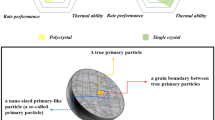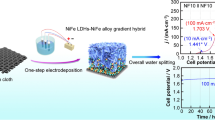Abstract
The low-cost and high-capacity metal oxides/oxyhydroxides possess great merits as anodes for lithium-ion batteries (LIBs) with high energy density. However, their commercialization is greatly hindered by insufficient rate capability and cyclability. Rational regulations of metal oxides/oxyhydroxides with hollow geometry and disordered atomic frameworks represent efficient ways to improve their electrochemical properties. Herein, we propose a fast alkalietching method to realize the in-situ fabrication of iron oxyhydroxide with one-dimensional (1D) hierarchical hollow nanostructure and amorphous atomic structure from the iron vanadate nanowires. Benefiting from the improved electron/ ion kinetics and efficient buffer ability for the volumetric change during the electro-cycles both in nanoscale and atomic level, the graphene-modified amorphous hierarchical FeOOH nanotubes (FeOOH-NTs) display high rate capability (~650 mA h g−1 at 2000 mA g−1) and superior long-term cycling stability (463 mA h g−1 after 1800 cycles), which represents the best cycling performance among the reported FeOOH-based materials. More importantly, the selective dissolutionregrowth mechanism is demonstrated based on the time tracking of the whole transition process, in which the dissolution of FeVO4 and the in-situ selective re-nucleation of FeOOH during the formation of FeOOH-NTs play the key roles. The present strategy is also a general method to prepare various metal (such as Fe, Mn, Co, and Cu) oxides/oxyhydroxides with 1D hierarchical nanostructures.
摘要
低成本、 高容量金属氧化物/氢氧化物作为具有更高能量密度的锂离子电池的负极材料时具有显著优势. 合理调控金属氧化物/氢氧化物的中空结构和无序的原子框架是提高其电化学性能的有效途径. 本文提出了一种快速碱刻蚀方法, 实现了非晶FeOOH分级纳米管的原位构筑. 得益于增强的电子/离子动力学和对循环过程中的体积变化的有效缓冲, 石墨烯修饰的非晶FeOOH分级纳米管展现出高倍率性能(在2000 mA g−1的电流密度下容量可达~650 mA h g−1)和优异的循环稳定性(循环1800次后容量仍保持在463 mA h g−1), 在目前报道的FeOOH基材料中处于领先水平. 研究表明碱刻蚀过程中的选择性溶解-再生长机制, 即FeVO4的溶解和FeOOH的原位成核再生长在非晶FeOOH分级纳米管的合成过程中具有重要作用. 此外, 这种选择性溶解-再生长机制是一种合成具有一维分级纳米结构的金属(例如Fe, Mn, Co和Cu)氧化物/羟基氧化物的普适方法.
Similar content being viewed by others
References
Lee J, Kitchaev DA, Kwon DH, et al. Reversible Mn2+/Mn4+ double redox in lithium-excess cathode materials. Nature, 2018, 556: 185–190
Larcher D, Tarascon JM. Towards greener and more sustainable batteries for electrical energy storage. Nat Chem, 2015, 7: 19–29
Kwade A, Haselrieder W, Leithoff R, et al. Current status and challenges for automotive battery production technologies. Nat Energy, 2018, 3: 290–300
Jiang Z, Xie H, Wang S, et al. Perovskite membranes with vertically aligned microchannels for all-solid-state lithium batteries. Adv Energy Mater, 2018, 8: 1801433
An Q, Lv F, Liu Q, et al. Amorphous vanadium oxide matrixes supporting hierarchical porous Fe3O4/graphene nanowires as a high-rate lithium storage anode. Nano Lett, 2014, 14: 6250–6256
Xiong F, Cai Z, Qu L, et al. Three-dimensional crumpled reduced graphene oxide/MoS2 nanoflowers: A stable anode for lithium-ion batteries. ACS Appl Mater Interfaces, 2015, 7: 12625–12630
Croguennec L, Palacin MR. Recent achievements on inorganic electrode materials for lithium-ion batteries. J Am Chem Soc, 2015, 137: 3140–3156
Obrovac MN, Chevrier VL. Alloy negative electrodes for Li-ion batteries. Chem Rev, 2014, 114: 11444–11502
Wei Q, Xiong F, Tan S, et al. Porous one-dimensional nanomaterials: Design, fabrication and applications in electrochemical energy storage. Adv Mater, 2017, 29: 1602300
Mai L, Tian X, Xu X, et al. Nanowire electrodes for electrochemical energy storage devices. Chem Rev, 2014, 114: 11828–11862
Zhao Q, Guo Z, Wu Y, et al. Hierarchical flower-like spinel manganese-based oxide nanosheets for high-performance lithium ion battery. Sci China Mater, 2019, 62: 1385–1392
Zheng M, Xiao X, Li L, et al. Hierarchically nanostructured transition metal oxides for supercapacitors. Sci China Mater, 2017, 61: 185–209
Liu J, Zheng M, Shi X, et al. Amorphous FeOOH quantum dots assembled mesoporous film anchored on graphene nanosheets with superior electrochemical performance for supercapacitors. Adv Funct Mater, 2016, 26: 919–930
Li D, Zhou J, Chen X, et al. Amorphous Fe2O3/graphene composite nanosheets with enhanced electrochemical performance for sodium- ion battery. ACS Appl Mater Interfaces, 2016, 8: 30899–30907
Lee NW, Jung JW, Lee JS, et al. Facile and fast Na-ion intercalation employing amorphous black TiO2−x/C composite nanofiber anodes. Electrochim Acta, 2018, 263: 417–425
Niu X, Zhang Y, Tan L, et al. Amorphous FeVO4 as a promising anode material for potassium-ion batteries. Energy Storage Mater, 2019, 22: 160–167
Jiang Y, Zhang D, Li Y, et al. Amorphous Fe2O3 as a high-capacity, high-rate and long-life anode material for lithium ion batteries. Nano Energy, 2014, 4: 23–30
Xiong F, Tao H, Yue Y. Role of amorphous phases in enhancing performances of electrode materials for alkali ion batteries. Front Mater, 2020, 6: 328
Kaneti YV, Zhang Z, Yue J, et al. Porous FeVO4 nanorods: Synthesis, characterization, and gas-sensing properties toward volatile organic compounds. J Nanopart Res, 2013, 15: 1948
Luo W, Jiang C, Li Y, et al. Highly crystallized α-FeOOH for a stable and efficient oxygen evolution reaction. J Mater Chem A, 2017, 5: 2021–2028
de Faria DLA, Venâncio Silva S, de Oliveira MT. Raman microspectroscopy of some iron oxides and oxyhydroxides. J Raman Spectrosc, 1997, 28: 873–878
Xiong F, Tan S, Wei Q, et al. Three-dimensional graphene frameworks wrapped Li3V2(PO4)3 with reversible topotactic sodiumion storage. Nano Energy, 2017, 32: 347–352
Qi H, Cao L, Li J, et al. High pseudocapacitance in FeOOH/rGO composites with superior performance for high rate anode in Liion battery. ACS Appl Mater Interfaces, 2016, 8: 35253–35263
Sun Y, Hu X, Luo W, et al. Synthesis of amorphous FeOOH/ reduced graphene oxide composite by infrared irradiation and its superior lithium storage performance. ACS Appl Mater Interfaces, 2013, 5: 10145–10150
Sun Y. Interfaced heterogeneous nanodimers. Natl Sci Rev, 2015, 2: 329–348
Misawa. The thermodynamic consideration for Fe-H2O system at 25°C. Corrosion Sci, 1973, 13: 659–676
Yu L, Xi S, Wei C, et al. Superior lithium storage properties of β- FeOOH. Adv Energy Mater, 2015, 5: 1401517
Song Y, Cao Y, Wang J, et al. Bottom-up approach design, band structure, and lithium storage properties of atomically thin γ- FeOOH nanosheets. ACS Appl Mater Interfaces, 2016, 8: 21334–21342
Zhang C, Zhu J, Rui X, et al. Synthesis of hexagonal-symmetry α- iron oxyhydroxide crystals using reduced graphene oxide as a surfactant and their Li storage properties. CrystEngComm, 2012, 14: 147–153
Zou M, Wen W, Li J, et al. Nano-crystalline FeOOH mixed with SWNT matrix as a superior anode material for lithium batteries. J Energy Chem, 2014, 23: 513–518
Peng S, Yu L, Sun M, et al. Bunched akaganeite nanorod arrays: Preparation and high-performance for flexible lithium-ion batteries. J Power Sources, 2015, 296: 237–244
Zhang X, Du Y. Gelatin assisted wet chemistry synthesis of high quality β-FeOOH nanorods anchored on graphene nanosheets with superior lithium-ion battery application. RSC Adv, 2016, 6: 17504–17509
Yu L, Wang LP, Xi S, et al. β-FeOOH: An earth-abundant highcapacity negative electrode material for sodium-ion batteries. Chem Mater, 2015, 27: 5340–5348
Zhang M, Han D, Lu P. PEDOT encapsulated β-FeOOH nanorods: Synthesis, characterization and application for sodium-ion batteries. Electrochim Acta, 2017, 238: 330–336
Acknowledgements
This work was supported by the National Key Research and Development Program of China (2017YFE0127600, 2016YFA0202600), the Program of Introducing Talents of Discipline to Universities (B17034), the National Natural Science Foundation of China (51521001 and 51602239), the National Natural Science Fund for Distinguished Young Scholars (51425204), Hubei Provincial Natural Science Foundation (2016CFB267), and the Fundamental Research Funds for the Central Universities (WUT: 2017-YB-001).
Author information
Authors and Affiliations
Contributions
Author contributions Mai L, Guo S, An Q, Lv F and Xiong F conceived the study. Lv F, Tang C and Xiong F carried out the experiments. Xiong F, Lv F, Tang C, Zhang P and Tan S participated in the data analysis. Xiong F and Lv F wrote the manuscript and Mai L, Guo S and An Q provided insights for the experiments and supervised the research. Tang C, Zhang P and Tan S modified the manuscript. All authors approved the final manuscript.
Corresponding authors
Ethics declarations
Conflict of interest The authors declare no conflict of interest.
Additional information
Fangyu Xiong received his BSc degree in material physics from Wuhan University of Technology (WUT) in 2016. He is currently pursuing his PhD degree and his current research interest focuses on the electrode materials for emerging energy storage devices.
Fan Lv is currently a PhD student in the Department of Materials Science and Engineering, Peking University under the supervision of Prof. Shaojun Guo. His current research interests focus on the development of nanostructured advanced energy materials for electrocatalysis.
Qinyou An is Associate Professor of materials science and engineering at WUT. He received his PhD degree from WUT in 2014. He carried out his postdoctoral research in the Laboratory of Prof. Yan Yao at the University of Houston in 2014–2015. Currently, his research interest includes energy storage materials and devices.
Liqiang Mai is the Chair Professor of materials science and engineering at WUT. He received his PhD from WUT in 2004. He carried out his postdoctoral research in the Laboratory of Prof. Zhonglin Wang at Georgia Institute of Technology in 2006–2007 and worked as an advanced research scholar in the Laboratory of Prof. Charles M. Lieber at Harvard University in 2008–2011. His current research interests focus on nanowire materials and devices for energy storage.
Shaojun Guo received his BSc degree from Jilin University (2005) and PhD degree from the Chinese Academy of Sciences (2010). He worked as a postdoctoral researcher associate at Brown University (2011–2013) and as a prestigious Oppenheimer Distinguished Fellow at Los Alamos National Laboratory (2013–2015). He joined the College of Engineering, Peking University in 2015 and is currently a Professor. His research interests focus on engineering nanocrystals and 2D materials for catalysis, renewable energy, optoelectronics and biosensors.
Supplementary Information
40843_2020_1337_MOESM1_ESM.pdf
In situ construction of amorphous hierarchical iron oxyhydroxide nanotubes via selective dissolution-regrowth strategy for enhanced lithium storage
Rights and permissions
About this article
Cite this article
Xiong, F., Lv, F., Tang, C. et al. In situ construction of amorphous hierarchical iron oxyhydroxide nanotubes via selective dissolution-regrowth strategy for enhanced lithium storage. Sci. China Mater. 63, 1993–2001 (2020). https://doi.org/10.1007/s40843-020-1337-5
Received:
Accepted:
Published:
Issue Date:
DOI: https://doi.org/10.1007/s40843-020-1337-5




